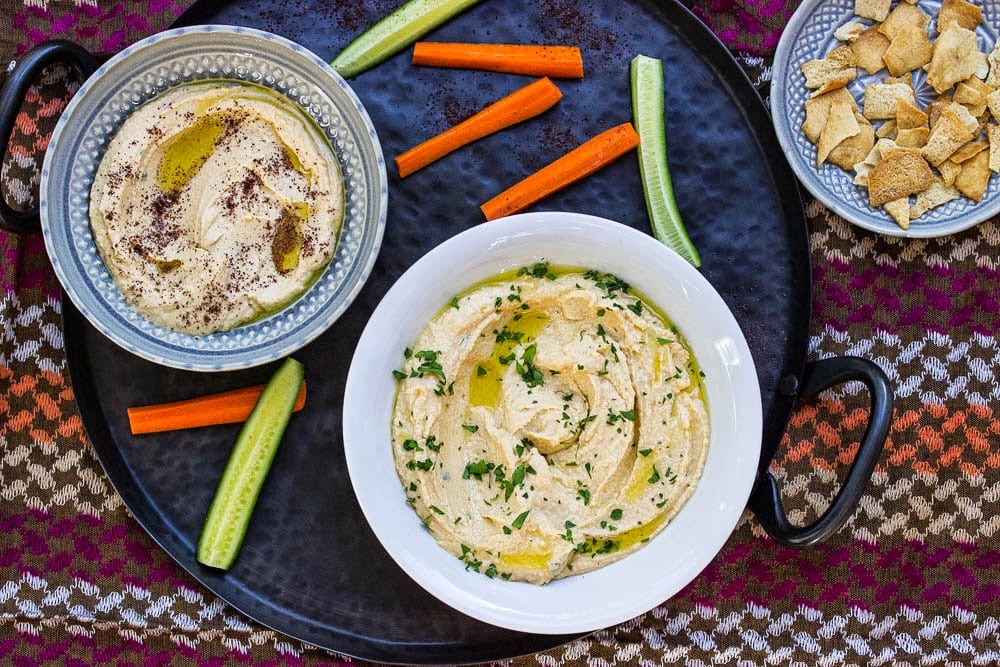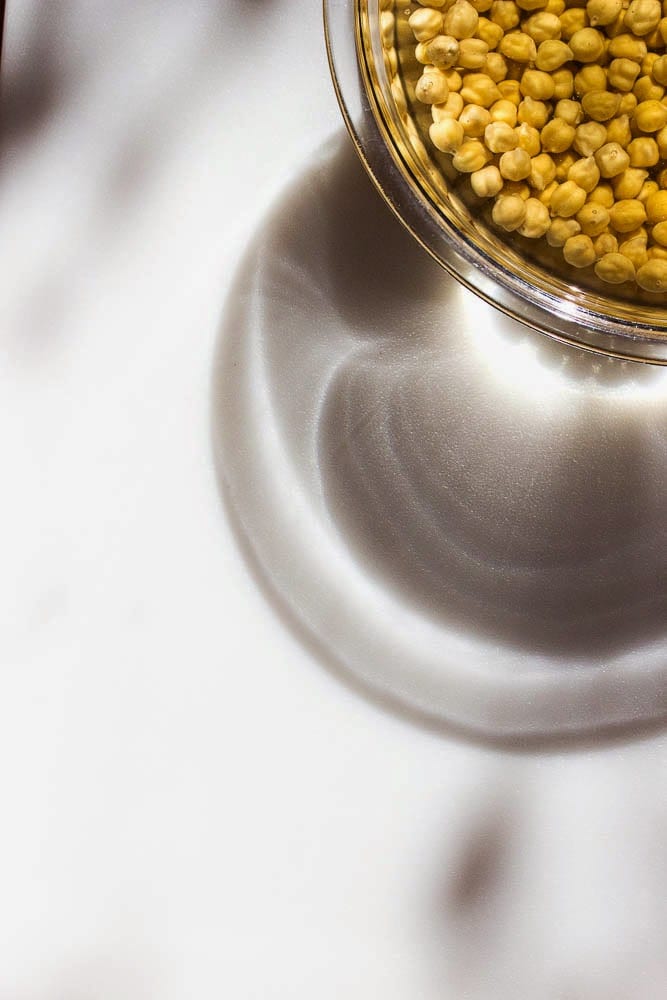It’s deliciously liberating to not have any attachments.
Soak dried chickpeas in plenty of water over night.
To not feel the glare, pressure and judgment of those wiser than you, those that have come before you, searing your back. Those mothers, grandmothers and great-grandmothers, that make a habit of pulling up a stool and comfortably perching themselves on your shoulders, watching your every move. Wagging their fingers at every sprinkle of sweet Spanish paprika. Tisking and tasking as they watch the lemon juice trickle through you fingers – announcing its presence on what were forgotten cuts and scrapes. And perhaps – just perhaps – if these elders are in a giving mood they might grant you one and only one nod of approval as they watch you release the chick peas from the embrace of their skins.
Stir the chick peas with baking soda in a pot over high heat, add more water and watch as the skins rise to the top. Magic.
You breathe a sigh of relief that you are not the carrier of this particular torch. Your shoulders feel weightless – free. This is your kitchen and your mood dictates your kitchen. For better or for worse.
Give the lemon juice, garlic and spices a whirl in the food processor to combine. I use sweet Spanish paprika because I also cook with the moods and taste buds of a five-year-old and eight-year-old in mind. Use smoky paprika if you prefer – or even a sprinkle of cayenne if your taste buds have fully developed. If you’re in the mood for a little more tang and general deliciousness (as I usually am), add the preserved lemons too. If not – don’t. Moody kitchen rules apply here.
Thousands of years of culture, debate and national pride cooly and casually bounce off of you and float off back into the ether. Back towards their homeland.
This “region” that so graciously gave birth to civilization, yet has struggled so to gently cradle it in its arms.
This vast swath of land – where passions run high – extremely high.
Where laughter can echo across its borders without need of passports, papers, religion.
Where tears have flooded its rivers, lakes and seas for far too long – far too long.
Where food – a simple meal prepared over a fire and shared with family, friends, neighbors, and strangers alike – is revered, debated, united, and is more integral to existence than any arbitrary lines etched out on a map.
Where every tribe, every neighborhood, every home will tell you that their preparation for Hummus bi Tahini – chickpeas with tahini is the BEST way, THE authentic way, the ONLY way.
Add the tahini (on this particular day my mood dictates to go easy on the tahini – so I do) with the saved chickpea broth (the water you cooked the chickpeas in – because my taste buds inform me this adds more flavor to the finished product). Give it another whirl.

But most of all, you are grateful that for once, your birth place – the very same land that for the first eight years of your life was the only home you knew – is not at the center of this particular regional discourse, debate, crisis. The politics of hummus might brush against the great peak of Mount Damavand, but it does not settle there. It continues on its journey. Becoming one again with the dust, the sea, and mountain ranges of Egypt, Lebanon, Palestine, Syria, Israel, Jordan.
Drop in the chickpeas and blend until smooth and creamy. Excersize patience. This might take a few minutes. If needed add a little more broth to thin out. Taste. Listen – and I mean really listen – to your taste buds. Add more of anything you think is lacking. Let the hummus rest in the fridge for at least thirty minutes before serving – it’s been through a long journey, after all. Bring to room temperature before serving (we can all use the time to acclimate) and drizzle liberally with olive oil. Serve as is or sprinkle top with anything your mood dictates.
You glance up and catch a legion of mothers, grandmothers, and great-grandmothers watching you from afar. You respectfully nod and acknowledge their presence. You are tempted to invite them to tea – but you don’t. They have a long journey ahead of them and many more homes to visit. They nod back and acknowledge that that they will not be staying today. You watch them turn their backs and leave.
You freely sprinkle in the sweet Spanish paprika.

A MOODY HUMMUS
Inspired by Melissa Clark’s Stupendous Hummus – Hyperion and Yotam Ottolenghi and Sami Tamimi – Ten Speed Press
NOTES:
- Make sure your dried chickpeas are not old. I don’t recommend buying them from bulk bins as they are usually old and have gone rancid. I purchase most of my organic legumes from here.
- I really prefer using dried chickpeas over canned. Especially because I use the cooking broth.
- Keep any left over over broth and use as a base for soups!
- I made my own preserved lemons last year (loosely following these recipes) and love them. But you can also purchase them at Middle Eastern or specialty grocery stores Give them a rinse under cold water before using. And remember you are using only the rind.
- Spanish paprika is also called pimenton. Feel free to use any type you prefer.
- I like to go easy on the tahini, but feel free to use as much as you like. Your kitchen – your mood – your taste buds!
Ingredients
1 1/4 cup dried chickpeas
1 teaspoon baking soda
Freshly squeezed juice of 2 lemons, plus additional if needed
1 teaspoon sea salt, if using preserved lemons, 1 1/2 teaspoons sea salt, if not using preserved lemons
1 fat garlic clove, chopped, or 2 or more (if your taste buds tell you so)
1/2 teaspoon cumin
1/4 teaspoon sweet Spanish paprika, or smoky paprika (depending on mood)
1/2 preserved lemon, chopped, (depending on mood)
1/3 cup tahini, (more if your mood dictate)
1/2 cup reserved chickpea broth, plus more as needed
Olive oil, as needed for drizzling
Sumac, as garnish, (if you’re in the mood)
chopped up parsley, as garnish, (if you’re in the mood)
1- Put dried chickpeas in a large bowl and cover with plenty of water. Soak overnight.
2- Drain the chickpeas. Place in a medium pot over high heat and add baking soda. Cook for about three minutes, stirring constantly. Add 5 cups of water or enough to cover chickpeas by at least 1 inch and bring to a boil. Turn heat down to medium/high and cook chickpeas. Skimming off any foam and any skins that rise to the top. Cook until the chickpeas are very tender but not mushy. This will take anywhere between 20 mins-1 hour, depending on freshness of chickpeas.
3- Drain the chickpeas. MAKE SURE YOU RESERVE THE BROTH, the cooking water. Set aside.
4- In a food processor combine the lemon juice, salt, garlic, cumin, paprika, and preserved lemon, if using. Pulse the mixture to combine. Scrape down the sides.
5- Add the tahini with 1/2 cup of chickpea broth. Give it a whirl to combine. Scrape down the sides.
6- Add the chickpeas and puree until smooth and creamy. This can take a few minutes. It took me about five minutes. Scrape down the sides and taste. With the motor running add more broth if necessary to make it nice and creamy. I usually end up adding another 1/4 cup of broth. Scrape down the sides. Taste. Listen to your taste buds. Adjust any and all flavors as you like.
7- Transfer hummus to a bowl and cover, and let it rest in the fridge for at least 30 minutes. Take it out of the fridge at least 30 minutes before serving. Drizzle a nice olive oil on top, and garnish with any spices or herbs, or just serve as is.
Hummus will keep in the fridge for up to 3 days. And it freezes beautifully for up to 3 months.




Comments (9)
This looks gorgeous. I'm not a huge fan of hummus because I think I overdid it in my undergraduate days. But back then I didn't know how glorious homemade hummus can be.
Thanks Sara! Once you've crossed over to homemade hummus there's no going back. I highly recommend it!
I follow almost the same recipe when making traditional hummus (with some very minor differences), but I've never tried serving it with preserved lemon. Next time!
Ksenia, I've been using my preserved lemons in almost everything. We've been loving it in hummus. Hope you get a chance to try and hope you enjoy!
Naz, I was hoping to find a good recipe of hummus, instead I read your post and my tears were coming down ….I sensed the present of my grandma, mom and those mothers who loved us so gently and judged us so harshly! Love your writing and your taste of music <3 and of course the recipe which I will try soon 🙂
Thank so much Fariba! It warms my heart that you enjoyed this post. Thank you for your encouragement and kind words. And I love it that you enjoy the music I share here!! Music is such an integral part to cooking in our house. One wouldn't happen without the other!
You have changed my life! I've been skinning the chick peas one by one. My husband wonders why I don't make more hummus.
Arika, here's to much more hummus making! I also don't get too caught up with making sure all the chickpeas are skinned. I skim off whatever rises to the top and skin any that are loosely hanging on after draining. Welcome back to hummus!
I read so many recipes then mixed them and forgot until I found my domesticated one, starting from canned chickpeas I drain them then add to my mortar where I started with fresh thyme, salt, garlic, lemon juice , home vinegar, and simply go on with my pestle. I like some still visible to bite … good Abruzzo evo oil. Your writing tastes excellent and one would go on reading smiling and enjoying. Thanks!